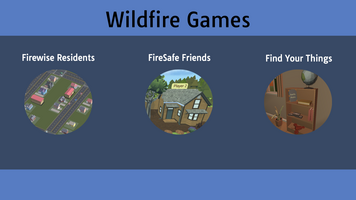Concept Chunking: a Minigames Approach to Tackle Complex Topics in Game Design


A major challenge with games for impact is the exceeding complex nature of the challenges being addressed. Our topic is no different -- wildfire poses many unique challenges in different circumstances, with many more potential ways to address each. Consider the different perspectives and aims before a wildfire, e.g. how to prepare or mitigate risks, versus what to do during or even after a wildfire.
When designing games to teach or raise awareness about such systems, it’s easy to get overwhelmed by the complexity. There’s science, safety protocols, risk perception, emotional factors—and that’s before we even start thinking about gameplay.
One strategy we relied on with our current project is concept chunking: breaking a big topic into smaller, digestible subtopics, then designing focused minigames that target each one through specific mechanics. Depending on the topic, progressive levels could be used in a similar way if the it is conducive to scaffolding knowledge or skills progressively, but in our case having each as a standalone minigame aligned well with the topics, and has the added benefit that a facilitator or teacher using the games in an educational setting can select the appropriate minigame(s) for the instructional setting and time available for the activity.
Here’s our step-by-step guide to designing in this concept chunking way:
Step 1: Map the Conceptual Terrain
Start by identifying the major ideas players need to understand or pain points that arise from the issue being addressed. For wildfire, this included:
-
Home hardening
Red flag warnings
-
Vulnerabilities of different households
-
Community interdependence
- Packing and leaving during an evacuation notice
Step 2: Break Into Chunks
Group related ideas into self-contained "chunks" that can be meaningfully explored in isolation. Each chunk should represent a decision, a risk, or a dynamic players can interact with.
Step 3: Match Chunks to Mechanics
Now for the fun part: turn each chunk into a gameplay experience. For example:
-
A home-hardening minigame where players fortify two houses and see how their changes affect fire spread.
-
A community evacuation simulation where players help different households decide when to leave and observe the consequences.
-
A packing activity where the player explores a house to prepare to evacuate and decides what to take.
Each game emphasizes the lived experience and choices involved, not just the facts.
Step 4: Choose Format: Minigames or Progressive Levels
If your chunks are conceptually distinct, make them into standalone minigames—ideal for modular learning and great for integrating into classroom activities or structure learning environments. If they need to build on each other (e.g. understanding leads to skill-building), design progressive levels that scaffold the learning step by step while still keeping the game mechanics tightly focused on the objective.
Step 5: Weave in Story and Context
Wrap each chunk in narrative. Let players meet characters, explore dilemmas, and feel the emotional stakes. This improves retention and encourages empathy.
By chunking concepts and aligning each with the right mechanics, we can design games that make complex topics not just understandable—but playable, personal, and memorable.
Wildfire Minigames Collection
A collection of minigames to help people develop preparedness and resilience to wildfire
| Status | Released |
| Authors | Wildfire UCSC, Yiyang Lu |
| Genre | Simulation |
| Tags | minigames, wildfire |
More posts
- Simulating Fire That Feels Real19 minutes ago
- From Workshop to Production – Turning Community Stories into Playable Scenario...1 day ago
- Critical Interdisciplinarity2 days ago
- When Good Ideas Go—Iterating with Communities and Experts2 days ago
- Building Empathy Through Storytelling and Role-Play3 days ago
- Multiplayer, Cooperation, and Discussion4 days ago
- Autonomy and Agency vs Gamification5 days ago
- The "Serious" Side of Serious Games: Staying True to Life6 days ago
- Reflections on Co-Design8 days ago

Leave a comment
Log in with itch.io to leave a comment.